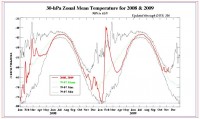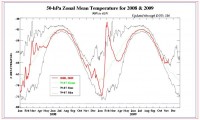Georgia Tech Press Release as reported on Watts Up With That
Reducing Greenhouse Gases May Not Be Enough to Slow Climate Change according to Georgia Tech press release here.
Georgia Tech City and Regional Planning Professor Brian Stone publishes a paper in the December edition of Environmental Science and Technology that suggests policymakers need to address the influence of global deforestation and urbanization on climate change, in addition to greenhouse gas emissions.

See larger image here.
According to Stone’s paper, as the international community meets in Copenhagen in December to develop a new framework for responding to climate change, policymakers need to give serious consideration to broadening the range of management strategies beyond greenhouse gas reductions alone.
“Across the U.S. as a whole, approximately 50 percent of the warming that has occurred since 1950 is due to land use changes (usually in the form of clearing forest for crops or cities) rather than to the emission of greenhouse gases,” said Stone. “Most large U.S. cities, including Atlanta, are warming at more than twice the rate of the planet as a whole - a rate that is mostly attributable to land use change. As a result, emissions reduction programs - like the cap and trade program under consideration by the U.S. Congress - may not sufficiently slow climate change in large cities where most people live and where land use change is the dominant driver of warming.”
According to Stone’s research, slowing the rate of forest loss around the world, and regenerating forests where lost, could significantly slow the pace of global warming.
“Treaty negotiators should formally recognize land use change as a key driver of warming,” said Stone. “The role of land use in global warming is the most important climate-related story that has not been widely covered in the media.”
Stone recommends slowing what he terms the “green loss effect” through the planting of millions of trees in urbanized areas and through the protection and regeneration of global forests outside of urbanized regions. Forested areas provide the combined benefits of directly cooling the atmosphere and of absorbing greenhouse gases, leading to additional cooling. Green architecture in cities, including green roofs and more highly reflective construction materials, would further contribute to a slowing of warming rates. Stone envisions local and state governments taking the lead in addressing the land use drivers of climate change, while the federal government takes the lead in implementing carbon reduction initiatives, like cap and trade programs.
“As we look to address the climate change issue from a land use perspective, there is a huge opportunity for local and state governments,” said Stone. “Presently, local government capacity is largely unharnessed in climate management structures under consideration by the U.S. Congress. Yet local governments possess extensive powers to manage the land use activities in both the urban and rural areas.”
The Environmental Science and Technology article is available here.
For more on land use change in the USA, see this NASA resource.
-------------------------
See response by Roger Pielke Sr. to the kneejerk reaction of Gavin Schmidt, Real Climate to Stone’s finding in the post
Comment On The Inaccurate Response By Gavin Schmidt Of Real Climate On The Role of Land Use Change On Temperature Trends
There is a response by Gavin Schmidt on Real Climate with respect to the role of land use change on the attribution of surface air temperature trends [thanks to Charlie Allen for alerting us to it!]. While Gavin has expertise in global climate modeling, his reply illustrates his lack of expertise on the role of landscape processes within the climate system, and, in this example, with respect to the role of land use/land cover change on long temperature trends.
The text from Real Climate is CCPO @258 - you quoted Gavin as saying “Note. global land use effects result in a cooling because the biggest issue is the chopping down of forest (dark) to make cropland (bright)” Well, that’s not actually true. Here’s a press release for a new paper from Georgia Tech, showing how 50% of the warming across the US is due to land use changes.
Original reference for Gavin’s comment was from Edward’s post @95:[Response: A statement in a press release is not a scientific result and the paper referred to does not show this to be true (and in fact I doubt very much that it is true). There are many papers on the global impacts of land cover change - Pondgratz et al is good, and all such papers show that land use at the global scale drives a cooling. - gavin]
The person who prepared the comment (CCPO) clearly understands the science issue better than Gavin Schmidt. I have already documented his lack of expertise in research topics that he comments on at Real Climate and elsewhere in my post Does Gavin Schmidt Understand Boundary Layer Physics?
A Recent paper of ours which document an increase in surface temperatures due to landscape change include: Fall, S., D. Niyogi, A. Gluhovsky, R. A. Pielke Sr., E. Kalnay, and G. Rochon, 2009: Impacts of land use land cover on temperature trends over the continental United States: Assessment using the North American Regional Reanalysis. Int. J. Climatol., DOI: 10.1002/joc.1996
With respect to the study by Stone Jr, Gavin apparently did not even read it before he commented! In the paper, (Stone Jr., Brian, 2009: Land Use As Climate Change Mitigation, Environmental Science and Technology), it is written [emphasis added in bold face font]
“...the mean decadal rate of warming across the urban stations is significantly higher than that of rural stations. Averaged over the full period, the mean decadal rate of warming for urban stations was found to be 0.08C higher than that of rural stations. This average rate of heat island growths i.e., urban warming in excess of the rural trends rises to 0.20C/decade over the most recent 20 years of observation.” and “The increasing divergence between rural and urban temperature trends in U.S. cities highlights the limitationsof a climate policy framework focused on emissions reductions alone. If land use change is the dominant agent of climate forcing at the urban scale, Kyoto-based emissions trading schemes may fail to sufficiently safeguard human health in the most heavily populated regions of the planet. It is important to emphasize, however, that the phrase “urban heat island effect,” much like the phrase “greenhouse effect,” is a misnomer…The physical mechanisms underlying warming trends in cities are limited neither to urban areas nor to small geographic regions. Rather, changes in surface moisture and energy balances accompanying land conversion processes across large swaths of the planet’s land area are giving rise to changes in climate that may be of the same order of magnitude as changes brought about through the emission of GHGs. As such, the urban heat island effect should be understood to be only the most visible manifestation of a larger phenomenon occurring across multiple geographic scaless a phenomenon better characterized as a “green loss effect” than as something unique to urban areas.”
This reply by Gavin, besides ignoring (e.g. Fall et al 2009) and his trivializing (e.g. Stone Jr 2009) peer reviewed papers that disagree with his perspective, his comment also shows that he has learned little from the exposure of the inappropriate attempt by Phil Jones and colleagues to serve as gatekeepers to climate science issues. Since Gavin Schmidt is not a recognized expert on the role of land use/land cover change, he should have sought a qualified climate scientist to address the comment by CCPO. Instead, he perpetuates the biased and often inaccurate presentation of climate views on Real Climate.
By Charlie Martin
Professor Roger Pielke Sr. is mentioned often in the Climategate data dump emails - generally unkindly. Professor Pielke is an atmospheric scientist at CIRES at the University of Colorado at Boulder, a professor emeritus at Colorado State University, a former Colorado State climatologist, and an active critic of the IPCC process. In a Pajamas Media exclusive, Dr. Pielke kindly agreed to an email interview regarding his reaction to the CRU emails and his opinion of their implications.
PJM: The release of the purloined emails and files from the UEA Climatic Research Unit has been a shock that still reverberates in the world of climate science, and among the critics of the current state of climate science. On the one hand, it has led some people to denounce “global warming” as a “hoax”; on the other, RealClimate.org apparently dismisses it as a tempest in a teacup. In your opinion, how important are these revelations?
Pielke: Both those who denounce “global warming” as a hoax and RealClimate’s claim that this is a “tempest in a teapot” are incorrect. With respect to the role of humans in the climate system, there is incontrovertible evidence that we exert both warming and cooling effects. The warming occurs through the emission of carbon dioxide and other greenhouse gases and certain aerosols, and cooling [occurs due to] other types of aerosols. Land use change due to human land management also effects warming and cooling forcings.
With respect to the RealClimate dismissal of the emails, however, there are serious issues exposed by the emails - including the goal of these scientists to prevent proper scientific disclosure of their data, as well as to control what papers appear in the peer reviewed literature and climate assessments. The IPCC assessment, with which major policy decisions are being made, involves the individuals in the emails who have senior leadership positions.
PJM: Do you feel these revelations suggest scientific misconduct on anyone’s part?
Pielke: I will defer to independent assessment of this particular episode. However, it is very important to realize that this is just a sample of what is a much broader goal of the leadership of the IPCC process to control what science the policymakers receive.
PJM: The CRU has now announced its intention to make all data freely available; at the same time, they announced that much of their raw data had been deleted/destroyed. Is the “value-added” data set useful? How much of a loss was the destruction of the original data? Can the original data be recovered, say, by returning to original source documents?
Pielke: The “value-added” terminology just means that they have adjusted the data based on a number of effects, each of which involves statistical uncertainty and bias. It certainly should be possible to return to the original data and recreate (and add photographs of the observing sites). However, the original data should also be at NCDC and GISS, so these sources of this information should be sought as well.
The photographs are essential, however, in order to determine if the locations where the temperatures are being observed are well-sited. Anthony Watts has documented that this is a major concern in the U.S. (Watts, A. 2009: Is the U.S. Surface Temperature Record Reliable? 28 pages, March 2009 The Heartland Institute), and this also appears to be true elsewhere in the world.
PJM: Do these revelations call the utility of the peer review system into question? Is it, as some have suggested, the worst method except for all the others? What changes could be made to improve peer review?
Pielke: This episode shows there are problems with the peer review process when editors (who are “judges") introduce their own biases in the review process with their selection of referees and with their decisions. One suggested improvement is to publish the reviews and papers (at least electronically) of all rejected papers and reviews of all accepted papers.
PJM: Anyone who has followed your blog for some years knows that you have had your own issues with the people included in the “Jones-Mann-Wigley clique.” Do you feel some degree of vindication now?
Pielke: Of course, it is always pleasant to have documentation that these individuals are inappropriately using their senior positions to prejudice the scientific assessment and publication process, as I have reported on my weblog for several years. What is more important, however, is that the significance of this breach of the scientific method be recognized by the policymakers and other scientific colleagues who have requested climate assessments.
PJM: George Monbiot has suggested that Dr. Jones should resign his position, and several people (ex. Hans von Storch, Eduardo Zorita) have suggested that Dr. Jones, Dr. Michael Mann, and others should be removed from the IPCC and excluded from the peer review process in the future. Indeed, Dr. Michael Hulme has suggested that the IPCC itself be abandoned for structural politicization of science. Do you agree with any or all of these suggestions?
Pielke: I am more concerned with the broader issue in this email exposure, of which these emails are just a small sample.
The IPCC process itself is inadequate, as we report in our new paper (Pielke Sr., R., K. Beven, G. Brasseur, J. Calvert, M. Chahine, R. Dickerson, D. Entekhabi, E. Foufoula-Georgiou, H. Gupta, V. Gupta, W. Krajewski, E. Philip Krider, W. K.M. Lau, J. McDonnell, W. Rossow, J. Schaake, J. Smith, S. Sorooshian, and E. Wood, 2009: Climate change: The need to consider human forcings besides greenhouse gases. Eos, Vol. 90, No. 45, 10 November 2009, 413. An edited version of this paper was published by AGU. Copyright 2009 American Geophysical Union). We report that the IPCC assessment did not consider all perspectives on the role of humans in the climate system.
This supports the viewpoint expressed by Dr. Michael Hulme that you listed in your question. We need a new assessment process.
PJM: Do you think these revelations should cause us to question the case for global warming - that is, for a general rise in average temperature over the last 400 or 1000 years - irrespective of cause?
Pielke: The data is quite convincing that there was warming at many locations around the Earth over the last hundred years. However, it is also convincing that warming has ceased, at least for the time being, since mid-2003.
Our research, however, has shown a warm bias in the surface temperature record over the last several decades, as reported most recently in this paper: Klotzbach, P.J., R.A. Pielke Sr., R.A. Pielke Jr., J.R. Christy, and R.T. McNider, 2009: An alternative explanation for differential temperature trends at the surface and in the lower troposphere. J. Geophys. Res., 114, D21102, doi:10.1029/2009JD011841.
We also document a set of unresolved uncertainties and biases in the surface temperature data in several of our other research papers. For example: Pielke Sr., R.A., C. Davey, D. Niyogi, S. Fall, J. Steinweg-Woods, K. Hubbard, X. Lin, M. Cai, Y.-K. Lim, H. Li, J. Nielsen-Gammon, K. Gallo, R. Hale, R. Mahmood, S. Foster, R.T. McNider, and P. Blanken, 2007: Unresolved issues with the assessment of multi-decadal global land surface temperature trends. J. Geophys. Res., 112, D24S08, doi:10.1029/2006JD008229.
Thus the magnitude of global warming using the surface temperature data trends overstates recent warming.
Read the rest of the interview here.
By Anthony J. Sadar
Regardless of the ultimate impact of the exposed e-mails from the University of East Anglia’s Climate Research Unit (CRU), numerous facts about the atmosphere surrounding climate change have always been apparent to the broad atmospheric-science community. The raw CRU e-mails, however, indicate that the gatekeepers of climate knowledge have limited what the public has been allowed to know about climate change.
Three important facts that have been sidetracked by the venerated gatekeepers include:
* There has never been an established consensus among scientists that humans are causing long-term, global climate change.
* Climate models have always been rather crude, inaccurate tools for projecting the worldwide trends of an extremely complex climate system.
* Water, not carbon dioxide (CO2) or any other greenhouse gas, has always been the most significant climate regulator on Earth.
Regarding the “consensus,” climate czar Carol Browner said she relies on those “2,500 scientists” from the U.N. Intergovernmental Panel on Climate Change (IPCC) to support her claim that human carbon emissions are likely pushing climate change. But not all of the 2,500 are actually climate scientists. The IPCC group consists of a mix of scientists, bureaucrats and governmental representatives, many of whom seem bent on a power-grab agenda.
The thousands of non-IPCC scientists specializing in atmospheric and climate-related work have never been quizzed as to their confidence in the hypothesis that humans are substantially responsible for changing the global climate. In addition, the official charge to the IPCC members is “to assess on a comprehensive, objective, open and transparent basis the scientific, technical and socio-economic information relevant to understanding the scientific basis of risk of human-induced climate change, its potential impacts and options for adaptation and mitigation” [emphasis added]. Note the directive to be “open and transparent.”
But, perhaps more important, the members are assigned the task of assessing “human-induced” climate change, which implies such inducing already exists. In essence, members seemingly are expected to support the theme of human-induced climate change, not to investigate the existence of such change.
As for modeling, although terrific for research and understanding the dynamics of the atmosphere, climate models are rather crude, inaccurate tools for long-term climate predicting with any specificity. For instance, in the real world, complex elements such as clouds have a profound effect on regulating the Earth’s surface temperature. Yet clouds are inadequately represented by the computer models designed to simulate them.
That brings us to water in general as a key climate regulator. As stated in the past, the global atmospheric temperature is “substantially controlled by water in all its forms, as invisible vapor in air, as liquid in oceans and clouds, and as solid ice crystals, snow cover and glaciers” (see, “In global warming we trust,” The Washington Times’ Commentary pages Feb. 23). But, government regulation of water based on the tactic that it’s a dangerous pollutant is a more difficult sell than the CO2-is-bad-for-polar-bears ruse. Besides, the claim that “CO2 is causing global warming” is itself a rather shallow proposition.
Deep ice core records going back hundreds of thousands of years show that global temperature increases lead global CO2 increases - that is, temperature goes up first followed by a rise in CO2. Surely such evidence should put the brakes on climate hysteria.
Despite good scientific reason to be skeptical of official pronouncements on climate change, the CRU e-mail revelation certainly sheds more light on climate-science machinations. But, let’s face it, the train hauling cargo boldly labeled “Humans are Causing Long-term Climate Change” has long-ago departed the station - and now it is heading full-throttle to the next stop in Copenhagen. Though it’s too late to flag the train before it pulls into the depot, at least the public is probably beginning to realize the train’s boldly labeled containers may in fact be empty.
Anthony J. Sadar is a certified consulting meteorologist and co-author of “Environmental Risk Communication: Principles and Practices for Industry” (CRC Press/Lewis Publishers, 2000).
Anthony Watts and Ryan Maue
Al Gore’s new book had a problem - no big hurricanes since Katrina to put in the book to look “threatening” to the USA. Any imagined link between hurricanes and global warming has evaporated.
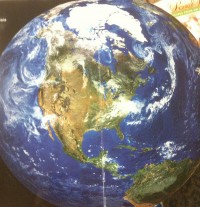
Solution: the artists airbrush.
Ryan Maue, hurricane expert from the University of Florida writes:
Anthony,
The cover opens and closes half and half - so you only see one hurricane, as in the press release photo or the one on Amazon.
But this is the real picture sequence from the book which I looked at Borders today and took cell-phone pictures, original (before the retouching by some “artist") Note all of the Arctic ice and the size of the Florida Peninsula.
and the final product:

WUWT?
A midget Southern Hemisphere cyclone is off the coast of Florida, another hurricane is sitting on the equator off the coast of Peru - and the Arctic Ice is gone (perhaps it is summer) and the Florida Peninsula is half gone.
There are other differences I am sure you can find - but the hurricanes are just nonsense.
Ryan
Here’s the book cover:
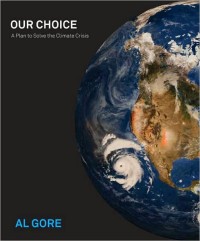
Nonsense? No more like scaremongering, especially when it has been shown time and again that there is no hurricane to global warming linkage, and we are at a 30 year low.

Mr. Gore, you are a charlatan.
Read post here.
By Ivan Kenneally
For years, the left has spun the debate over global warming in the starkest Manichean terms. Those who disagree with the scientific and policy orthodoxy have been maligned as greedy capitalists bent on raping the earth of its natural resources for cheap material gain; they have been cast as the benighted enemies of reason itself. Efforts to publicly challenge the science behind global warming have too often resulted in professional and political character assassination. To be skeptical about the fashionable scientific and policy platform aggressively advocated by the mainstream media and self-indulgently championed by the Hollywood elite is nothing less than an “assault on reason,” to borrow Al Gore’s hyperbolic rhetoric. In predictably technocratic fashion, the left has claimed its own peculiar position as the only scientifically legitimate one - everything else reduces to craven interest, manifest dishonesty, or antiquarian faith.
However, maintaining this self-serving narrative just got a lot harder. In the last few days, the cause of climate alarmism took a big hit when more than a thousand e-mails exchanged by scientists at the University of East Anglia’s Climactic Research Unit (CRU) suddenly surfaced online. These e-mails were published by the computer hackers who apparently stole them, a crime that should be investigated and prosecuted. But notwithstanding the e-mails’ route to publication, their actual content is extraordinary. These behind-the-scenes discussions among leading global-warming exponents are remarkable both in their candor and in their sheer contempt for scientific objectivity. There can be little doubt after even a casual perusal that the scientific case for global warming and the policy that springs from it are based upon a volatile combination of political ideology, unapologetic mendacity, and simmering contempt for even the best-intentioned disagreement. Especially in anticipation of the major climate summit taking place in Copenhagen next month, the significance of this explosive disclosure is hard to underestimate. According to climatologist Patrick J. Michaels, “This is not a smoking gun; this is a mushroom cloud.”
The evidence of scientific dishonesty supplied by these communications is so copious it’s hard to know where to begin an attempt to describe them. Many of the e-mails brazenly discuss the manipulation of scientific data either to provide the appearance of greater support for global warming science or to undermine the claims of skeptics. For example, CRU scholar Timothy J. Osborn explicitly describes how data can be reconfigured so that evidence of an apparent cooling period disappears. His colleague Tom Wigley discusses recasting the data on sea-surface temperatures so that the results seem considerably warmer but also scientifically plausible. The director of CRU, Phil Jones, brags about his use of eminent climatologist Michael Mann’s “Nature trick” which deliberately confuses scientific data to “hide the decline” in current temperatures.
Other e-mails openly encourage the suppression of data that could prove difficult to repudiate. Michael Mann provides strategic advice on how to deal with a journal, Geophysical Research Letters, that seems to be open to publishing views that dissent from climate orthodoxy. In an e-mail to Phil Jones, Mann also expresses his desire to “contain” the very inconvenient truth of the Medieval Warm Period, so important in overthrowing Mann’s classic “Hockey Stick” model of anthropogenic warming, even though he admits they don’t have an appropriate model to do that legitimately.
Public spokesmen for the global warming agenda constantly claim a near-universal consensus within the scientific community supporting their position, but these private exchanges often reveal serious personal reservations regarding what they really know and how confident they are in the statistical models they rely upon. In an e-mail to several prominent climate scientists (including Mann and Jones), Kevin E. Trenberth, one of the leading contributors to the work of the Intergovernmental Panel on Climate Change, offers this confession: “The fact is that we can’t account for the lack of warming at the moment and it is a travesty that we can’t. The CERES data published in the August BAMS 09 supplement on 2008 shows there should be even more warming: but the data are surely wrong. Our observing system is inadequate.” In another e-mail, Trenberth admits climatologists have a limited understanding of where our energy ultimately goes, what the effects of cloud formation might have on the entire issue, and expresses doubts about the efficacy of geoengineering to provide any substantive relief, again saying that the gaps in the scientific knowledge amount to “a travesty.” All of this a far cry from the strident claims about unimpeachable evidence and demonstrable theory that usually emanates from these quarters.
Perhaps the most damning e-mails concern CRU deputy director Keith Briffa’s analysis of the diameter of tree rings in Yamal, Siberia. That research is a major evidentiary pillar in support of twentieth-century global warming and it helped resurrect Michael Mann’s “Hockey Stick” graph of global warming. The scientist largely responsible for challenging Mann’s work, Steve McIntyre, turned his attention to Briffa’s resurrection of it and accused him of cherry-picking samples that would confirm his politically desirable hypothesis.
The response to McIntyre’s work revealed in the CRU e-mails shows a breathtaking pattern of ideological rigidity and academic fraudulence that is simultaneously egregious and casually self-satisfied. First, it becomes clear that the global warming crowd, in particular Mann and Osborn, are quick to dismiss McIntyre’s work as “not legitimate science” even before reviewing his studies. Their initial reflex is not to scrutinize McIntyre’s analysis or to reconsider their own entrenched positions but rather to respond with a kind of angry, territorial protectiveness. Then they collectively identify someone who could, in fact, “shed light on McIntyre’s criticisms of Yamal” but choose not to contact him because he “can be rather a loose cannon.” Another scientist who might have helped clarify the Yamal situation is dismissed by Mann for being “not as predictable as we’d like.” Unquestioning loyalty to a political platform is understood to be the precondition of scientific authenticity.
Even worse, in response to the charge that Briffa’s work is difficult to verify because he withholds key data from the published study, Tom Wigley actually issues a justification of the practice:
And the issue of withholding data is still a hot potato, one that affects both you [Phil Jones] and Keith [Briffa] (and Mann). Yes, there are reasons - but many good scientists appear to be unsympathetic to these. The trouble here is that withholding data looks like hiding something, and hiding means (in some eyes) that it is bogus science that is being hidden.
Wigley provides no discussion at all regarding what would count as an appropriate reason for concealing data, or what benefit this could bring to the scientific community at large. One is left to wonder if the justification for hiding information is political rather than scientific. Mann seems unconcerned that any of these issues will resonate with a friendly media: “Fortunately,” he wrote to a New York Times reporter, “the prestige press doesn’t fall for this sort of stuff, right?”
In his “Memorandum on Scientific Integrity” from earlier this year, President Obama stated that it is the function of “science and the scientific process” to “inform and guide” his administration on virtually every issue from health care to national security. This came on the heels of his promise in his inaugural address to “restore science to its rightful place,” and his boast that his administration will “base” its “public policies on the soundest science,” indicating that the proper relation between politics and science subordinates the former to the latter. The classic concern about science - that it might become dangerously liberated from moral or political guidance - is not what concerns President Obama in his memorandum and speeches. Rather, he worries about the suppression or politicization of unambiguous scientific fact. If the president’s words are taken at face value, his administration should seriously reconsider its enthusiastic embrace of aggressive climate legislation, since the CRU e-mails reveal a political appropriation of science instead of a science liberated from political pressure.
Hillary Clinton famously remarked that during the Bush years it was “open season on open inquiry,” rehashing the familiar charge that a faith-based obscurantism dogmatically dismissed not only the claims of legitimate science, but also the very claims of reason itself. President Obama has stayed true to the liberal posture that whatever policy he happens to advocate is the only one substantiated by empirical science. However, it has become increasingly clear that the president’s claim to rigorously adhere to a science of politics - a science that provides unprejudiced information upon which he can craft sound policy - has been overtaken by a politics of science - the crass and Procrustean transformation of whatever data is available into further confirmation of his own ideological commitments. Australian writer Andrew Bolt has suggested that the CRU e-mail leak is a “scandal that is one of the greatest in modern science.” But the greater scandal may be that the United States and the rest of the world are considering enacting energy-restrictive and economy-damaging climate policies based on ideological distortions of scientific fact. Read more here.
Ivan Kenneally is an assistant professor of political science at the Rochester Institute of Technology. He is writing a book on technocracy in American politics.
By Charles Battig
The October 30, 2009 WSJ edition provides confirmation of the job generating potential of the clean energy revolution so often mentioned by President Obama. Rebecca Smith’s article reports on the new green jobs resulting from the 36,000 acre wind farm in Texas. Unfortunately the jobs are being created in China; I thought that the President was talking about U.S. jobs.
Federal tax credits and millions of dollars of federal funding will be sought to create 2,800 jobs. Great, except that the article notes that the U.S. share of those green jobs would be all of 15%---420 jobs. The other 85% are created in China! The managing partner of the private equity firm behind this project is quoted as calling this a “win-win for everyone.” I say not quite everyone. It is presumably a win for his equity firm and a win for the Chinese turbine manufacturer. The loser in this game would be the U.S. taxpayer, forced to front the costs of this project and pay to ship jobs overseas. Wind power is touted as free, clean energy. Shrewd investors and manufacturers are happy to fulfill this fantasy with taxpayer money. The reported experiences of wind power in Denmark, Germany, and Spain note no closing of coal fired power plants as a result of wind power coming on line. Russian natural gas becomes the alternate back up power source when the wind fails.
Another report in the same WSJ details the Chinese march forward with nuclear powered plants, with plans to have as many as 100 on line in twenty years, up from 11 today. Here in the U.S., nuclear power continues to be hamstrung by environmental groups such as the Sierra Club, and by onerous permitting obstacles. The world’s first AP1000 third generation reactor, pioneered by U.S. Westinghouse, is to be located , not in the U.S., but in China. China is also reported to be the prime manufacturing site for the solar panels used in Germany.
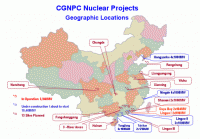
See larger image here.
China has seen the future and it sees that it is jobs and plentiful energy. This is something to remember here as the U.S. Federal energy policy is intent to make energy more expensive via Cap/Tax and Trade legislation. China is happy to fulfill our clean energy fantasies, take our green jobs, while building a new coal power plant each week, and building next-generation nuclear power plants.
Charles Battig, M.S., M.D.
President, Piedmont Chapter
Virginia Scientists and Engineers for Energy and Environment
Charlottesville, VA
By Joseph D’Aleo
Below is a cross section of height/temperature anomalies for the Polar Regions (65-90N). Note each time the warming reached into the mid Troposphere, the AO Index tanked. The negative AO was why October was 3rd coldest in 115 years for the United States (below, enlarged here)
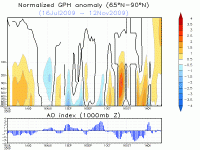
It has retreated to higher levels and the AO has recovered for the time being. That is why the US turned warmer this month. See that warming spread into the arctic high atmosphere (30mb) from the Pacific side (below, enlarged here).

See animation from early October for 30 mb here. See the 1 month animation at 50 mb here.
See in the following charts how the temperature has exceeded long term maximum for those levels.
See here how this developed in 2005 in this cross section. Note the big mid tropospheric warming in late November and December with a collapse of the AO. No guarantee that this will repeat but shows you what happens when it reaches significant levels.
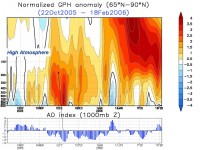
Enlarged here.
See the result in the December 1-22 period.
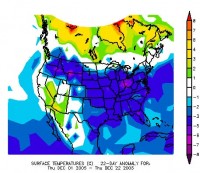
Enlarged here.
See what the best matches for an El Nino, low solar, east QBO winter would suggest for upper levels (below, enlarged here).

Amazingly similar to winters when the warmest waters were located in central Tropical Pacific and cold eastern areas (below and enlarged here).
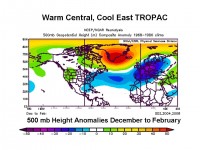
Note the tendency in both for a negative NAO (positive heights to the north in the Atlantic and lower height south). The negative NAO correlates to cold in the eastern half of the US (and western Europe) (below, enlarged here).
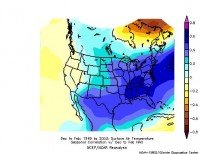
What could go wrong? A false alarm with the warming for one. A stronger El Nino with more warming in the east would change the story (currently we expect it to peak early late November or early December. Indeed the strong westerly wind bursts causing this second surge has turned back to tropical easterlies which should enhance upwelling and mix the warm water up and see the Kelvin wave return west as a Rossby wave which will elevate the thermocline and dissipate the El Nino by mid-winter it like it did in 2002/03 and other low solar east QBO years with a cold PDO). If the stratospheric warming is real and does increase, look for major cooling starting around or just after Thanksgiving. Time will tell.
See more here.
By Art Horn, the Art of Weather and Icecap Meteorologist
I recently visited the new Connecticut Science Center located in Hartford Connecticut. It is very impressive! The staff was friendly and very helpful. Parking was easy and reasonable, well sort of reasonable. Getting around the building was no problem. The exhibits where easy to see and there was a lot of interactive displays for kids to touch and play with. I’m not so sure how this helps prevent the spread of germs but there were hand sanitizer dispensers spread around. However I found the climate change movie they presented very disturbing. It is completely one sided and biased. It shows the alarmist point of view (I noticed Greenpeace in the credits) and there was no attempt to show any science that there is another point of view. The film actually used the Michael Mann tree ring temperature reconstruction of the last 2,000 years.
The rather stern host of the film, an animated sheep who never smiles during the entire 20 minutes actually dies at the end of the movie by falling off the moon! As he falls you can hear him cry out as we watch him plummet to oblivion. The host actually crashes into the screen as he meets his death at the end of the movie! They never actually show him dead but the meaning is clear. Amazingly there is a statement at the end of the film that says no sheep were harmed in the making of this movie. Well sure but they killed a fake one for dramatic impact! This was the not too subtle message that if we don’t stop burning fossil fuels we could all suffer the same fate.
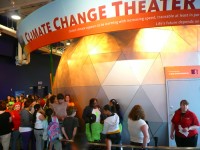
This movie is clearly an attempt to scare children. Small children are watching the humorless host talk to them about how bad global warming is and then he is killed. One can only wonder about what kind of nightmares this could trigger in some kids. It would be much more scientific and less alarmist if the film presented both sides of the story so people and kids could make up their own minds as to what is true and what is hype. Below is what I sent to the director of the Science Center.
The inconvenient science
1. Surface temperature records show that global temperature fell from 1875 to 1910. Temperature rose from 1911 to 1943. Temperature fell again from 1944 to 1976. Temperature rose from 1977 to 1998. There has been no warming since 1998. We are now in the 8th year of cooling. While all these changes were happening carbon dioxide levels did nothing but go up.
2. There 5 major centers that collect global temperature data, Remote sensing systems, The University of Alabama Huntsville, The Goddard Institute for space studies. The Hadley Center and the Nation Oceanographic and Atmospheric Administration. All of these centers show no warming since 1998 and all show cooling to varying degrees for the last 8 years.
3. NASA said this summer that the oceans are warmer than ever before. This was accomplished by subtracting the satellite measured ocean temperature data. NASA also does not use the 3307 ARGO buoys deployed in the world oceans because they show ocean heat content has been falling since the buoys were deployed in 2003.
4. There is no statistical relationship between carbon dioxide levels in the atmosphere and temperature during the last 150 years. There is a strong statistical relationship between the cyclic Pacific Decadal Oscillation and global temperature. In every instance over the last 150 years when the PDO was in the cool phase the global temperature went down. When the PDO was in the warm phase the temperature went up. The PDO has shifted back to cool and the temperature is falling again.
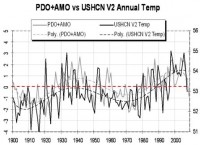
See larger image here.
5. The total carbon dioxide in the atmosphere is 3.8 one hundredth of a percent. The total increase by volume of carbon dioxide in the atmosphere in the last 150 years is one hundredth of a percent.
6. Carbon dioxide is not pollution. Everything that grows on earth needs it. The source is irrelevant. Remove all the carbon dioxide from the air and the earth dies.
7. There are many large organizations, environmental groups, corporations, universities, media outlets and politicians that have a strong financial interest in having you believe carbon dioxide is pollution. The saying “follow the money” was made for global warming. A vast carbon trading market is being generated around the world to take advantage and capitalize on of the fear of global warming.
8. Ice cores show that increases in carbon dioxide in the past were the result of warmer temperature, not the cause of it. The laws of nature have not changed. Most of the increases in carbon dioxide in the air is the result of nature. The human component is very small, on the order of 3 percent per year. Carbon dioxide is 3.5 percent of the greenhouse effect. Water vapor is 95 percent. Since human activity only adds 3 percent a year the total human contribution to the greenhouse effect each year is about one quarter of one percent.
9. There is a strong relationship between the strength of the solar wind and global temperature. Strong solar wind equals a warmer earth, weak solar wind equals a cooler earth. Variations in cosmogenic isotopes of carbon 14 and beryllium 10 in ice cores prove this. Right now the solar wind is weaker than anytime that NASA has been able to measure it, nearly 50 years and the earth is cooling. The Pacific Ocean in it’s cool phase and will be for another 25 years. The Atlantic is showing signs of cooling. The sun is weak and will likely be so for the next two solar cycles. We are heading for colder temperatures, not warmer.
10. The cyclic downward trend in the amount of ice left in the Arctic at the end of the summer has ended. There is today 25 percent more ice than 2 years ago.
11. Satellite measurements show there is more ice in Antarctic than 30 years ago. News media reports only talk about shrinking ice in the Arctic, never about growing ice in Antarctica. They are selling fear.
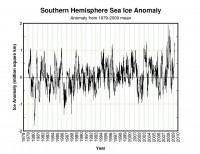
See larger image here.
12. In the 1960s there were an estimated 5,000 polar bears, today there are 25,000. In a typical biased story in April of this year TIME magazine reported there were “only” 25,000 left. Once again this story had major input from environmental groups.
13. The melting of glaciers is not new (see here.). The “Little Ice Age” was from 1400 to 1850. The coldest temperatures were in the 1600s. Global temperature has been rising unevenly for 300 years. Glaciers have been retreating unevenly for at least 250 years.
14. Computer models say that there should be a rapid warming of the upper troposphere between 30 degrees north and south of the equator if global warming is proceeding as they predict. Measurements with weather balloons over the last 50 years so no such warming at all. This proves the computer models do not understand how the climate system works. They can’t predict the climate 50 to 100 years in the future. Computer model forecasts of warming are not evidence of climate change. They are marketing tools for research groups to continue their funding.
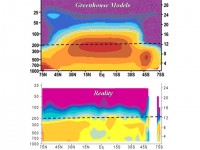
See larger image here.
15. Data from the Earth Radiation Budget Satellite show outgoing longwave radiation (heat) increased by 4 watts per square meter in the 1980s and 1990s while the oceans were undergoing a cyclic warming. Computer models predicted outgoing longwave radiation would decrease as oceans warmed. All the models used by the IPCC were wrong.
16.The Intergovernmental Panel on Climate Change was formed in 1986 to prove human burning of fossil fuels causes global warming. It is not a scientific organization, it is political. Recently the chairman of the IPCC Rajendra Pachauri announced “We’re at a stage where the warming is happening at a much faster rate.” Apparently he does not look at real world data.
17. As for Al Gore. Beware prophets seeking profits.
See PDF here.





